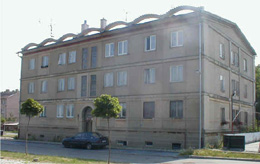
The first panel building in Prague had a human scale and comfort 55 years ago
 |
| First experimental panel building at U Prefy 771 |
The first experimental panel building at U Prefy 771, constructed in 1953, has an interesting history. A new construction system, the so-called skeleton panel, was developed for it, authored by Miloslav Wimmer. The project was submitted in 1948, and it used a so-called type T16, which allowed for more generous interior spaces in standardized construction. A number of groundbreaking construction solutions were used in the building process. A lightweight ceiling panel was patented, and during its development, bionics was utilized for the first time (analogous to the evolutionary development of the natural structure of horsetails over 150 million years). An innovative ornamental surface treatment of the panel was also introduced to enhance its technological properties.
The construction of the prototype faced obstacles as a new initiative. An opposing assessment by structural engineers claimed that the construction was "on the verge of instability" and living in a building assembled from individual panels would not be safe. Construction only continued after this opinion was refuted by the recognized expert in concrete construction, academician Stanislav Bechyně, who confirmed the original tests demonstrating eleven times the safety of the skeleton. Thus, the building welcomed its tenants on July 1, 1955 (from the beginning, its creator Miloslav Wimmer also lived there). Unlike later panel buildings, it was characterized by having a gabled roof with a gentle slope and decorative cornices, and the panels were covered with plaster. It offered its residents a decent comfort with twelve 3+1 apartments measuring nearly 100 square meters. For comparison, a 3+1 panel apartment from the 70s measured about 60 square meters.
Apart from a few implementations, the construction of skeleton panel buildings did not progress. The reinforced concrete skeleton was expensive, and there was a lack of capacity and technology for mass production (skeletons and panels were manufactured on-site). They were replaced by types G40 and others that employed structures from prefabricated panels. The first five-story building labeled G40 was built in 1953 in Zlín. In Prague, the first larger housing estate constructed from these buildings was built in Pankrác at Na Zelené lišce (1954 to 1955). Panel buildings at that time were adorned with various details, house signs, arcade entrances, and mosaics that quickly disappeared during mass construction.
Panel buildings represented a rapid solution to the housing crisis in socialist Czechoslovakia, with most of them constructed between 1958 and 1990. In 1985, panel construction accounted for nearly 99 percent of all new apartments in residential buildings.
Standardized and impersonal panel housing estates created entirely new urban districts and significantly altered the character of cities (an example being Prague's Jižní Město or Brno's Bohunice).
In the Czech Republic, there are around 1.2 million panel apartments, in which more than three million people live. Nearly 700,000 panel buildings are over 35 years old, and more than 60 percent of the housing stock needs a total renovation. Originally, panel buildings were designed for a lifespan of approximately 40 years, but some experts suggest their supporting structures could last an additional 50 years. However, the rapid and inexpensive construction came at the expense of quality. Issues often arise from poor thermal insulation of the exterior envelope or roof, the end of lifespan of the apartment cores, and inadequate electrical installations. Funding for the repair of panel buildings is primarily provided by the State Housing Development Fund as part of the Panel program (interest subsidies), and the Ministry of Regional Development also supports the regeneration of panel housing estates.
The English translation is powered by AI tool. Switch to Czech to view the original text source.
0 comments
add comment











